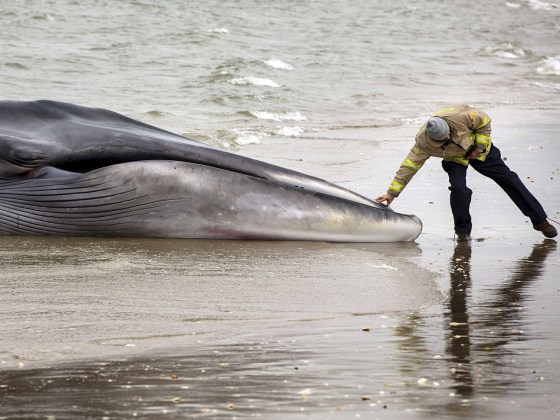Fourteen beaked whales — identified by their peculiar snouts — washed ashore together on a beach in the Canary Islands on Sept. 24, 2002.
When biologists performed an autopsy of eight of the whales, they found deep tissue damage in the animals caused by pockets of gas. Scuba divers who go deeper than 60 feet stay are wary to avoid "the bends," painful nitrogen bubbles that form in the bloodstream when humans swim to the surface too quickly. Diving mammals were thought to be immune to "the bends" — yet, here were 14 dead whales with the telltale bubbles in their organs.
The sad part was, the rapid surfacing that likely killed the whales appeared to have been caused by human actions.
The beaching started 4 hours after international navy fleets began running military exercises involving sonar, just off the coast. There seemed to be some link between the sonar, and the decompression sickness, and the beachings, but the researchers who cut up the poor whales didn't really know how the mass tragedy came about. (After sonar activity was banned by the Spanish government in 2004, mass strandings stopped, say the researchers.)
New research from a group of Arctic biologists at the University of Tromso in Norway adds a clue piece to the story of how diving mammals like whales and dolphins regulate the gas in their bodies, and why decompression sickness might lead to strandings like the Canary Islands incidents. They described their findings in June 20 edition of the Journal of Experimental Biology.
Human divers have long been taught the dangers of resurfacing too quickly. Because the pressure underwater is much greater than the pressure of the Earth's atmosphere at sea level, the gases in our bloodstream — taken in when we breathe — dissolve in greater quantities the deeper we dive. If we're too quick to come up, the pressure is released too quickly, and gas bubbles emerge from the bloodstream, causing discomfort, pain and sometimes death.
One biological trick used by seafaring mammals to counteract this effect is seen in fatty pockets that surround the most delicate of their blood vessels.
"It looks like very very fine spaghetti: The red [blood] vessels and the white fat next to it," Michael Moore, who studies dead whales and their diving physiology at the Woods Hole Oceanographic Institute in Massachusetts, told NBC News. The fat acts like a trap for gas, so when nitrogen comes gushing out, it gets mopped up, acting like a buffer against the bends.
In their new paper, Arnoldus Blix and a team look at slices of harbour porpoise tissue and describe pockets of fat surrounding certain networks of blood vessels. They show that the fat is strategically placed, and that the blood rushing to the brain first pass through one such carefully regulated nitrogen sponge.
But if animals are surprised by sudden noises, heading up towards the surface more abruptly than usual, the balance maintained by the fat might not be enough to keep the animal safe. Bubbles of nitrogen in the bloodstream would head to the brain, they suggest, which could lead to a beaching. As to whether the whales strand because they are neurologically impaired and can't navigate — or if it's because they are in pain or because of some other factor entirely — that's something that still needs to be studied, Moore says.
Arnoldus Blix, Lars Walloe and Edward Messelt are authors of "On how whales avoid decompression sickness and why they sometimes strand" published online in the Journal of Experimental biology on June 20.
Nidhi Subbaraman writes about science and technology. Follow her on Facebook, Twitter and Google+.
